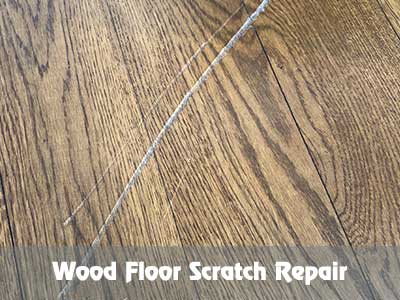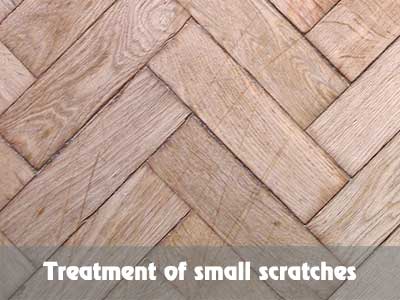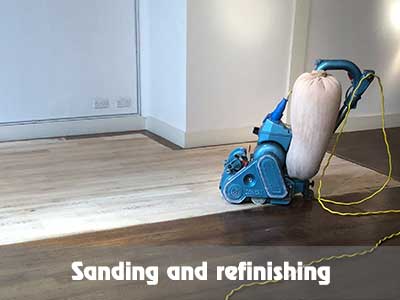Wood Floor Scratch Repair
 Scratched vintage floors may look interesting and intriguing with their character, old-world charm and unique appearance. However, you may not be so happy when your new and beautiful hardwood floor gets scratched. Even fine and small scratches on the surface of the floor can quickly make the floor look worn, sad, tired, and old. To avoid that, good prevention and proper upkeep are important for keeping your floor in pristine condition and looking brand-new.
Scratched vintage floors may look interesting and intriguing with their character, old-world charm and unique appearance. However, you may not be so happy when your new and beautiful hardwood floor gets scratched. Even fine and small scratches on the surface of the floor can quickly make the floor look worn, sad, tired, and old. To avoid that, good prevention and proper upkeep are important for keeping your floor in pristine condition and looking brand-new.
However, you cannot prevent scratches forever, and even thorough and regular maintenance will not help you escape from the fact that scratches will sooner or later happen and affect the way your floor looks. Worry not, because an experienced and reliable wood floor repair team will ensure all necessary and advanced treatments that will bring your hardwood floor back to its initial beauty and durability. Wood floor scratches can be treated in different ways depending on their size, depth, and to they are affecting the condition of the wooden floor.
Here are some of the most popular and efficient techniques for taking care of wood floor scratches.
Understand the Finish of the Floor
We recognise the importance of understanding the type of finish applied to your wood floor. Various finishes and sealants protect your flooring from imperfections like scratches, dents, and general wear and tear. When a scratch occurs, it's often a sign of a weakened or worn finish in that specific area.
Our skilled team specialises in recoating scratched areas to restore the uniformity and smoothness of your floor's surface. Knowing the exact type of finish on your floor is crucial for determining the best treatment method for scratches. If you're unsure about your floor’s finish or how to identify it, don’t hesitate to contact our reliable wood floor repair team. We offer professional inspections and provide you with all the information you need to maintain your floors in impeccable condition.
Thorough Cleaning of Troubled Areas for Optimal Results
We understand that effective scratch repair begins with a thorough cleaning of the affected area. Before we treat any damaged or scratched spots, our skilled technicians will carefully and thoroughly clean the surface to remove all dust and dirt particles. This important step prevents further scratching during the repair process.
For more serious or deeper scratches, we ensure that even the insides of the cracks are completely free of debris. Our team utilises a slightly damp mop or cloth along with a specialised cleaning product designed specifically for hardwood flooring, ensuring a neutral pH that won’t compromise the finish layer. By preparing the area properly, we create the ideal foundation for a successful and lasting repair.
Expert Treatment for Small Scratches

At FlooringFirst!, we know that even small scratches can be a concern for homeowners who want to maintain the beauty of their wood floors. While some scratches may not be immediately visible, it's important to address them before they become larger issues. Our experienced team offers specialised treatment for such imperfections, ensuring your flooring looks its best.
Although household remedies may sometimes be used, we urge you to rely on our professional expertise for the most effective solutions, especially for small and fine scratches. Our technicians can assess the situation and recommend the best repair method. If the scratch appears lighter than the surrounding floor, we can use a blending pencil in the appropriate colour to seamlessly fill in the imperfection, restoring the floor's flawless appearance.
Finish Restorer for Light Scratches
Our wood floor repair specialists utilise high-quality finish restorers to effectively treat faded finishes or light scratching on your hardwood floors. If your flooring requires attention across a larger area—or even the entire surface—our finish restorers are an excellent solution.
These specialised products are designed to efficiently address minor scuffs, marks, and scratches without damaging the wood itself. Our team is equipped to assess your flooring needs and apply the appropriate finish restorers, revitalising your floors and enhancing their overall appearance. Trust us to bring back the lustre of your wood floors with our professional restoration services.
New Coat of Finish for Medium Scratches
We have the expertise to treat medium scratches that have only minimally damaged your wood floor's surface by applying a new coat of finish. This method is ideal when the existing finish allows for recoating, eliminating the need for complete re-sanding and refinishing. Our professionals are skilled in working with finishes like oils that do not require sanding before the application of new layers. We ensure that the new finish closely matches the existing one, significantly reducing the risk of color variation. By hiring our experienced team, you can trust that your wood floors will receive the highest quality care and attention, restoring their beauty and extending their lifespan.
Professional Sanding and Refinishing Services

We offer the most efficient solution for eliminating scratches and imperfections from your wood floors through our expert wood floor sanding and refinishing services. If you’re looking to achieve a flawless, brand-new appearance, or if the scratched area is extensive and spot treatments seem overwhelming, our reputable wood floor repair and restoration team is here to help.
Our sanding process strips away the old finish, effectively removing small imperfections such as scratches, dents, marks, and dirt buildup. This not only revitalises the surface but also opens the pores of the wood, allowing the finishing products to penetrate deeply. Once completed, the applied coats ensure robust protection both at the surface and within the wood structure, enhancing your floor's durability and resilience. Trust us to bring your wood floors back to life with our professional sanding and refinishing services.
Gap Filling for Deep Gouges
We specialise in gap filling services designed to address deep gouges, scuffs, and cracks in your wood flooring. Our expert team uses a high-quality mixture of resin and sawdust to effectively fill these imperfections, significantly improving the floor's condition and appearance.
Once the gaps are filled, we carefully sand the treated areas to ensure a seamless finish. Following this, we apply fresh coats of finishing products to restore the beauty and durability of your wood floors. Trust our professionals to revitalise your flooring and enhance its insulation and aesthetics with our gap filling service tailored for deep gouges.
Maintaining the beauty and integrity of your wood floors requires prompt attention to scratches and imperfections. At FlooringFirst!, our comprehensive range of services—from minor scratch treatments to major repairs like sanding, refinishing, and gap filling—ensures that every aspect of your flooring receives expert care. With our experienced team and high-quality products, we are committed to restoring your wood floors to their original charm while enhancing their durability for years to come. Don’t let scratches diminish your flooring’s appeal - contact us today to learn more about our services and let us help you keep your wood floors looking beautiful and brand new.
Say Goodbye to Scratches and Scuffs on Your Wooden Floors
Unsightly scratches, scuff marks, and surface damage can dull the look of your wooden floors. At FlooringFirst!, we offer expert wood floor scratch repair services that restore your floor’s smooth finish and natural beauty. From minor touch-ups to full refinishing, we’ve got the tools and skills to make your floor look like new again.
Frequently Asked Questions About Wood Floor Scratch Repair
Can you remove deep scratches from a wood floor without sanding the entire room?
Deep scratches can often be improved with fillers and colour-matching techniques, but for a flawless result a full sanding may be required. We’ll advise the best option after inspection.
How do you fix surface scratches or scuff marks?
Light scratches and scuffs can usually be buffed out and re-coated, or touched up with blending stains and sealants. This makes them far less visible without major work.
Will the repaired scratch area look the same as the rest of the floor?
We carefully colour-match and blend finishes so repairs are discreet. On well-maintained floors, repaired areas usually become virtually invisible once the finish cures.
How long does a scratch repair visit take?
Minor scratch repairs can often be completed within 2–3 hours. Larger or multiple repairs may take longer, especially if a new protective coat needs drying time.
Do you offer scratch repair for both oiled and lacquered floors?
Yes — we work with both finishes. For oiled floors, we may spot re-oil the area; for lacquered floors, we use specialised blending products or apply a fresh topcoat for consistency.
Get in touch with us or book a free site visit and let our team restore the flawless look of your hardwood floors.